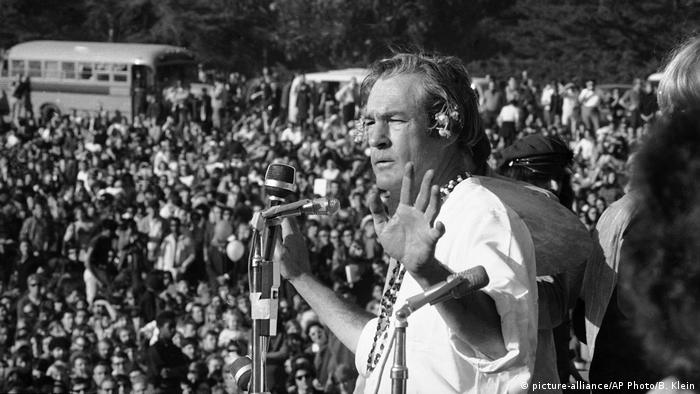
How the Summer of Love came to San Francisco 50 years ago
DW.com, n.d.
https://www.dw.com/en/how-the-summer-of-love-came-to-san-francisco-50-years-ago/a-40236165
During the summer of 1967, thousands of flower children streamed across America towards California searching for love, freedom, drugs and music. Their dream? A life free from conventions.
Haight-Ashbury in 2017: The San Francisco neighborhood almost looks as if the clock stopped 50 years ago. Psychedelic-looking house facades and graffiti proclaiming love and peace for all can be seen everywhere. There are flower power bars and second-hand shops selling hippie accessories such as Buddha figures, water pipes, and beaded jewelry. A burger joint even splashed the words “Summer of Love” onto its colorful exterior.
The house prices in this former hippie hangout haven’t remained the same since 1967, however. Real estate values have boomed over the decades. Property here is expensive. Whoever lives here has made it – and now must share their streets with the tourist buses that drive through Haight-Ashbury every few minutes.
Marijuana on every corner
It has been a particularly busy in 2017. Over the past months young people have descended upon San Francisco to celebrate the 50th birthday of the Summer of Love right where it all started – in the harbor city’s famed Golden Gate Park, in the streets of Haight-Ashbury, in bars and clubs.
Hashish and marijuana can be found on every corner in every form. Smoking pot recreationally is legal in California, though marijuana can not yet be sold commercially.
The people that come here have a nickname: wannabe hippies. They are young people longing to experience a feeling they have never known – this special spirit of the Sixties. Only the old hippies, scattered few and far between the young generation’s self-styled flower children, can tell tales of what it was really like half a century ago.
A free, simple and good life
During the mid-1960s, Haight-Ashbury was a magnet for young dreamers, Beatniks, and all those on the hunt for a free and self-determined life. All the movement’s key thinkers and leaders lived here: poet Allen Ginsberg, musicians Jerry Garcia, Jimi Hendrix and Janis Joplin, psychologist Timothy Leary. It seemed possible to lead an alternative life here, one that is free of convention, consumption and societal obligations.
The streets overflowed with free music, drugs and sex, all of which were tolerated, for the most part. The era’s biggest bands – Jefferson Airplane, the Grateful Dead, the Byrds – gave free concerts. Haight-Ashbury was a pilgrimage destination for thousands of Americans and even Europeans.
Another type of world actually seemed possible here, one full of love, freedom and self-autonomy.
‘Turn on, tune in, drop out’
The Summer of Love began on January 14, 1967, when some 30,000 people gathered in San Francisco’s Golden Gate Park. They came to take part in counterculture poet Allen Ginsberg and writer Gary Synder’s “Human Be-In” initiative, part of the duo’s call for a collective expansion of consciousness.
On that winter day, psychologist Timothy Leary spoke the words that would become the motto of the summer: “Turn on, tune in, drop out!”
And Scott McKenzie’s song “San Francisco,” released in May that same year, provided the summer’s soundtrack with its famous line, “If you’re going to San Francisco, be sure to wear some flowers in your hair.”
Read more: Summer of Love: Beatles album ‘Sgt. Pepper’s’ turns 50

Psychologist Timothy Leary tells some 30,000 hippies in Golden Gate Park: “Turn on, tune in, and drop out.”
A faded dream
The number of inhabitants living in Haight-Ashbury rose rapidly, and the area earned the nickname “Hashbury” due its high concentration of drug usage. People would sit on the streets, make music and get stoned. In the parks they danced, celebrated and, naturally, “made love.”
At first, the mass gathering was peaceful, but as more and more people arrived during the summer, the peaceful mood reached its tipping point. Too many homeless, too much filth and too many illnesses – and the drugs got harder and harder.
By fall, few traces remained from the Summer of Love. Many of the original hippies fled, their dreams, destroyed by drugs and commerce, were just faded memories. In October 1967, some hundred or so hippies united and declare an end to the Summer of Love. A symbolic funeral procession marked the death of hippie culture.
Izu, one of few original hippies still in Haight-Ashbury, offers tours that include the former house of the Grateful Dead
Court cases instead of Love and Peace
One highlight of this year’s 50th anniversary celebration could have been a free music festival in Golden Gate Park on August 27.
The Council of Light, a group that came together out of the original movement in the 1960s, had wanted to organize a 2017 festival like they had on the 40th anniversary in 2007, in which contemporary musicians and those from the mid-1960s would perform side-by-side. Tibetan monks were even invited to lead a communal awakening.
The city denied the organizers a permit due to security considerations, too few toilets, volunteer staffing, inadequate evacuation route plans, among other issues. The correspondence between the organizers and the responsible municipal office, as well as the subsequent court case, lacked any sign of the spirit of the Sixties.
Yet hippie history remains an integral part of the city of San Francisco. It is greeting its visitors on the 50th birthday of the Summer of Love with everything imaginable related to hippie culture, cliché as it sometimes may be.
Celebratory events are taking place throughout 2017, from concerts to gatherings – and even a Summer of Love exhibition in the de Young art museum that the San Fransisco-based culture magazine The Bold Italic recommends visiting while stoned.





